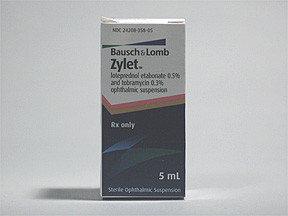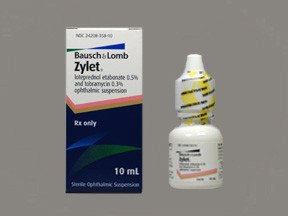TOBRAMYCIN/LOTEPREDNOL - OPHTHALMIC SUSPENSION
PHONETIC PRONUNCIATION: (TOE-bra-MYE-sin/LOE-te-PRED-nol)
COMMON BRAND NAME(S): Zylet
GENERIC NAME(S): tobramycin/loteprednol etabonate
Uses
USES: This medication is used to treat conditions involving swelling (inflammation) of the eyes and to treat or prevent bacterial eye infections. This product contains tobramycin, an antibiotic that works by stopping the growth of bacteria. It also contains loteprednol, an anti-inflammatory corticosteroid that works by reducing swelling, redness, and itching. This medication treats/prevents only bacterial eye infections. It will not work for other types of eye infections and may worsen them (e.g., infections caused by viruses, fungi, mycobacteria). Unnecessary use or overuse of any antibiotic can lead to its decreased effectiveness.
How to use TOBRAMYCIN/LOTEPREDNOL - OPHTHALMIC SUSPENSION
HOW TO USE: This medication is applied to the eye(s) as directed by your doctor. To apply eye drops, wash your hands first. To avoid contamination, do not touch the dropper tip or let it touch your eye or any other surface. Shake the bottle well before each dose. Do not wear contact lenses while you are using this medicine. Sterilize contact lenses according to manufacturer's directions, and check with your doctor before you begin using them again. Tilt your head back, look upward, and pull down the lower eyelid to make a pouch. Hold the dropper directly over your eye and place one drop into the pouch. Look downward and gently close your eyes for 1 to 2 minutes. Place one finger at the corner of your eye (near the nose) and apply gentle pressure. This will prevent the medication from draining out. Try not to blink and do not rub your eye. Repeat these steps if your dose is for more than 1 drop and for your other eye if so directed. Repeat as often as directed by your doctor. Your dosage is based on your medical condition and response to therapy. Do not rinse the dropper. Replace the dropper cap after each use. If you are using another kind of eye medication (e.g., drops or ointments), wait at least 5 minutes before applying other medications. Use eye drops before eye ointments to allow the eye drops to enter the eye. Do not use this medication more often than prescribed or for longer than 2 weeks unless directed by your doctor. Use this medication regularly in order to get the most benefit from it. To help you remember, use it at the same times each day. Continue to use this medication for the full time prescribed, even if symptoms disappear after a few days. Stopping the medication too soon may allow bacteria to continue to grow, which may result in a return of the infection. Inform your doctor if your condition does not improve in 2 days.
Side Effects
Precautions
Interactions
Overdose
Images
Reviews
Faq for TOBRAMYCIN/LOTEPREDNOL - OPHTHALMIC SUSPENSION
Tobramycin/Loteprednol ophthalmic suspension is a medication used to treat eye infections and reduce inflammation in the eyes.
Tobramycin is an antibiotic that kills or prevents the growth of bacteria causing infections in the eyes. Loteprednol is a corticosteroid that reduces inflammation and swelling in the eyes.
This medication is commonly used to treat bacterial eye infections, including conjunctivitis (pink eye), blepharitis, and keratitis. It is also effective in reducing inflammation associated with post-operative cataract surgery.
You should follow the instructions provided by your doctor or pharmacist. Typically, 1-2 drops are instilled into the affected eye(s) every 4-6 hours or as directed by your healthcare professional.
Some common side effects may include temporary stinging or burning sensation in the eyes, blurred vision, eye redness, or increased sensitivity to light. If you experience severe or persistent side effects, contact your doctor immediately.
It is generally recommended to avoid wearing contact lenses while using Tobramycin/Loteprednol ophthalmic suspension. Consult your eye care professional for guidance on when it is safe to resume wearing contact lenses.
If you miss a dose, use it as soon as you remember. However, if it is almost time for your next dose, skip the missed dose and resume your regular dosing schedule. Do not double dose to make up for a missed one.
Yes, Tobramycin/Loteprednol ophthalmic suspension can be used in children. However, the dosage and duration of treatment may vary based on the age and condition of the child. Consult a pediatrician for appropriate guidance.
The duration of treatment will depend on the type and severity of the eye infection or inflammation. Follow your doctor's instructions and complete the full course of treatment to ensure the infection is fully eradicated.
Disclaimer
IMPORTANT: HOW TO USE THIS INFORMATION: This is a summary and does NOT have all possible information about this product. This information does not assure that this product is safe, effective, or appropriate for you. This information is not individual medical advice and does not substitute for the advice of your health care professional. Always ask your health care professional for complete information about this product and your specific health needs.


No Reviews Yet